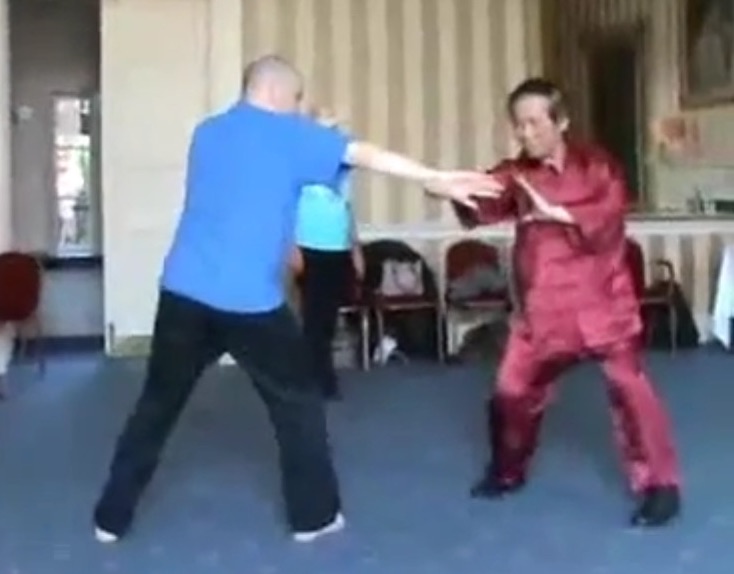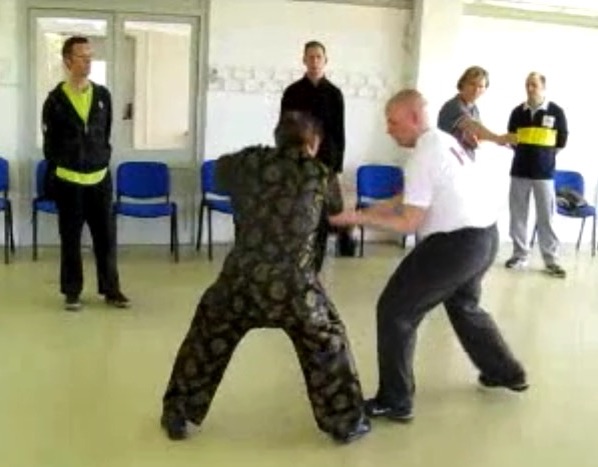CHIN-NA AND BAGUAZHANG

"Smooth hand Leads Away" in the second of Eight Baguazhang Combat Ssequences
Question
I've always been curious about the role of qin na in Baguazhang. My personal experience practicing Baguazhang and other martial arts has impressed upon me the immense usefulness of qin na, despite some translations of the methods of Baguazhang deriding it, saying things such as:
- Baguazhang does not emphasize joint-locking or grabbing,
- My skill is not superior if I grab a person.
- Grabbing is not appropriate to deal with multiple opponents,
- It is best to employ a direct attack and directly withdraw.
Fred Chu
Answer
Baguazhang is well known for its footwork, like getting to the back of an opponent to attack him. It is not noted for chin-na. It is also not known for its felling technique, because while footwork is important in felling, it is different from that in Baguazhang. More than 90% of Baguazhang attack deals with strikes, primarily with the palm.
Nevertheless, in my opinion, if you use chin-na effectively, it will enhance your specialization of Baguazhang. You should also take note that the nature of Baguazhang techniques are not particularly favorable for chin-na, but if you can add chin-na into your Baguazhang, you can surprise many opponents in combat.
Before answering your fundamental question as to how I chose chin-na techniques in the Swimming Dragon Baguazhang Set, I would like to comment on the statements made by some Baguazhang practitioners deriding chin-na as mentioned by you.
"Baguazhang does not emphasize joint-locking or grabbing."
It may be a matter of translation, but chin-na is not just joint-locking and grabbing. If you lock an opponent’s joint, or grab him, you yourself are also immobilized during combat. When you let go of the lock or grab, your opponent can continue to fight you. But if you release your chin-na technique, he cannot fight further because your chin-na would have disabled him from further fighting.
"My skill is not superior if I grab a person."
That may be true of most Baguazhang practitioners because Baguazhang is not made for chin-na. But if you are already good at Baguazhang and add chin-na to it, without distracting from its combat efficiency, you will be more combat efficient.
As an analogy, most Western trained doctors would find their treatment of patients compromised if they try to treat their patients according to traditional Chinese medicine, which is very different from the way they have been trained in Western medicine. But if you are well trained in chi kung healing, which is part of traditional Chinese medicine, and apply it without affecting your Western medical training, you will be more efficient in treating your patients.
Not many Western trained doctors have a chance to learn chi kung healing well. Similarly not many Baguazhang practitioners have a chance to learn chin-na well.
"Grabbing is not appropriate to deal with multiple opponents."
This statement is only true for those who are not well trained in combat application in general and in chin-na in particular. And most martial artists are poorly trained in combat application and in chin-na. This is evident from the facts that many martial artists accept being punched and kicked for granted during sparring, and that chin-na is rarely taught. But if you are well trained in combat application and in chin-na, you can use chin-na to effectively deal with multiple opponents.
"It is best to employ a direct attack and directly withdraw."
This statement is true for some times, but not true for other times. If your opponents are highly skillful, it may not be good to use direct attack or withdraw directly. It is better to use tactics and strategies to trick them to fight the way you want, and attack them when situations are favorable. When you have applied chin-na techniques on them, it is unwise to withdraw directly. It is better to deepen your chin-na techniques on them until they concede defeat.
Moreover, you can use chin-na to attack directly and withdraw directly if the combat situation warrants it. In fact, many chin-na students who do not have the opportunities to learn tactics and strategies as well as combat philosophy, often attack and withdraw directly. In the coming Chin-Na Course, participants will have the opportunity to learn tactics, strategies and combat philosophy.
My choice of chin-na techniques for our Swimming Dragon Baguazhang Set was made unconsciously. I did not consciously think of combat principles when choosing them for the set. But this does not mean that I chose them haphazardly. My choice, though unconscious at the time, was based on my understanding of kungfu philosophy and my experience of sparring and fighting. I felt that the chin-na techniques as well as all other techniques were the best for their particular combat situations.
There are not many chin-na techniques in the Swimming Dragon Baguazhang Set. One chin-na technique is "Smooth Hand Lead Away" in Sequence 2, which uses one hand to hold and grip an opponent’s horizontal sweep
Another is “Leisurely Grab Goat”, which is found in Sequence 3, and is similar to “Old Eagle Catches Snake” in Shaolin Kungfu and Taijiquan. This pattern is also found in other sequences of the Swimming Dragon Baguzhang Set. Here two hands are used to hold and grip an opponent’s striking arm.
As chin-na is not important in Baguazhang, there are no special force training techniques or methods to train chin-na skills. The usual methods to develop internal force in Baguazhang are stance training, especially the pattern “Green Dragon Tests Claw”, and the eight mother palms, like what we did during the Baguazhang course at the UK Summer Camp many years ago. When practitioners have developed substantial internal force in Baguazhang, they will be forceful in chin-na techniques as well as all other techniques.
As there are many force training methods in our school, any relevant methods will do. But “Fierce Tiger Cleanses Claws”, which I shall teach at the coming Chin-Na Course, is particularly effective.
When our students have developed substantial internal force with any of our force training methods, like the consolidate method of Triple Stretch, or the flow method of Taijiquan, they can apply their internal force to chin-na techniques or any other techniques effectively. Indeed, our students with internal force may be more forceful in chin-na than chin-na students who practice jabbing their hands into beans or gripping Y-shaped branches.
More importantly, besides effective chin-na application, internal force contributes to good health, vitality and longevity, whereas jabbing into beans and gripping Y-shaped branches only contribute to chin-na efficiency.

"Leisurely Vrab Goat" in the thrid of the Eight Baguazhang Combat Sequences
The questions and answers are reproduced from the thread 10 Questions on Shaolin Chin-Na in the Shaolin Wahnam Discussion Forum.
LINKS
